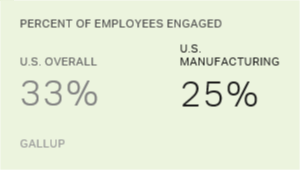Should companies take different approaches to managing employees of different generations?
This question has been top of mind for managers in recent years. For example, younger workers were a key focus in the 1990s, when a youth culture characterized many of the IT companies that were driving unparalleled economic growth. Recently, with the graying of the baby boom generation, managing older workers has become a common topic. However, a Gallup study suggests that when it comes to employees' level of engagement with their jobs, it may not be the oldest workers who are most at risk -- nor the youngest for that matter.
Gallup's measure of employee engagement consists of 12 items that consistently predict positive workplace outcomes, including increased retention, productivity, profitability, and customer engagement and improvements in safety and absenteeism. A random sample of about 7,700 American workers (excluding managers) were asked to respond to these items between January 6, 2009, and April 5, 2009. The large sample allowed for close analysis of how engagement levels vary by demographic and job categories across the U.S. workforce. (See graphic "The Three Types of Employees.")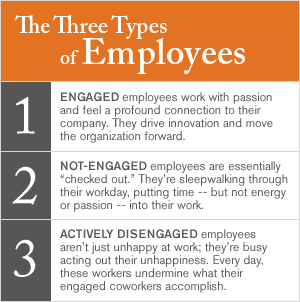
The results indicated that the ratio of engaged to actively disengaged workers -- a metric that serves as a summary indicator of workplace conditions -- was lowest among employees aged 30-59. Employees in this age range are more likely to be actively disengaged, meaning they exhibit a negativity that can spread to coworkers and erode an organization's bottom line. The percentage of actively disengaged workers was highest among those aged 40-49 (22%). Workers in this age group were almost 1.5 times as likely as those aged 18-29 or those aged 60 and older to be actively disengaged (15% for both the youngest and oldest age groups). (See graphic "The Frustrating Forties.")
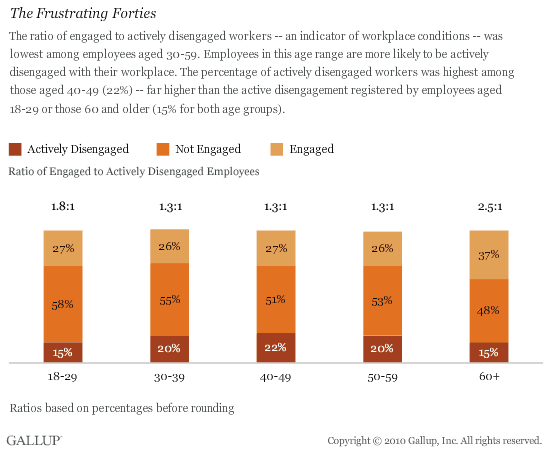
Losing the focus on development
Examining the responses to specific items provided clues to the factors that drive greater discontent among workers in the middle age groups. Ratings for items that relate to employees' personal development tended to sag most in the middle groups -- and particularly among employees aged 40 to 59.
As these age differences indicate, once employees are past early adulthood -- the years when many are learning the ropes in their chosen profession -- they become significantly less likely to strongly agree that their workplace is a source of personal development. This perception drops even further among workers in their 40s and 50s, who are significantly less likely to strongly agree that someone at work encourages their development and that they have opportunities at work to learn and grow. These percentages rise sharply again among those in the oldest age group, which could include employees who have deferred retirement and who have stayed in the workforce by choice rather than necessity. (See graphic "Arrested Development?")
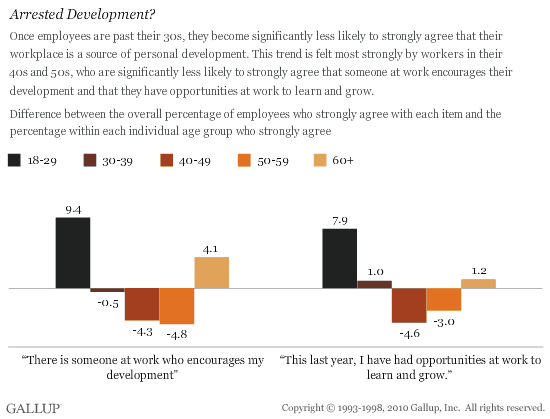
Do these trends really matter? After all, shouldn't employers naturally be less focused on developing workers as they grow older and become more experienced? Perhaps, but ignoring employees' development needs -- regardless of their age -- won't keep those workers productive and engaged. Workers aged 40-59 who strongly agree with both the "development" and "learn and grow" engagement items were significantly more likely than other employees to say they experienced happiness and enjoyment the previous day and significantly less likely to say they experienced worry or stress.
Does job type matter?
In reviewing theories about how age-related changes affect work motivation, psychologists Ruth Kanfer, Ph.D., and Phillip L. Ackerman, Ph.D., noted that some job types are more likely than others to have a clear development track that may help keep people engaged in their careers over the long term. "Among professional workers, for example, opportunities for work role change may sustain high levels of work motivation throughout the life course," they write. "In contrast, for service workers performing routinized tasks (e.g., custodians), the dearth of opportunities for work role changes may increase the likelihood of work role deficits in midlife and late adulthood." (See "Aging, Adult Development, and Work Motivation" in the "See Also" area on this page.)
Gallup's 2009 employee engagement research reveals that age trends do differ by job type for some items. For example, the proportion of professional workers who strongly agree that "There is someone at work who encourages my development" is well above average among those aged 18 to 29, then drops to slightly below average for all age groups between 30 and 59. For workers with jobs in the service, manufacturing, transportation, and installation/repair categories, the proportion who strongly agree with the same item drops further below average among those 40 to 59 before recovering among those 60 and older.
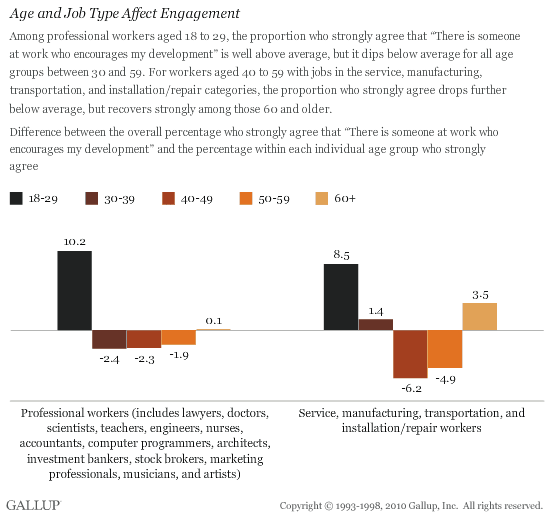
Conclusion
Gallup research has consistently demonstrated that local workgroup conditions have a significant impact on employees' productivity and emotional investment in their jobs. But the aging process also influences how employees view their work, as demonstrated by psychologists' findings that life goals and motivational factors tend to shift as people grow older. And as a multitude of career switchers can attest, midlife is a time when many people reevaluate their goals and make changes accordingly.
Great managers understand these needs and continually communicate with employees about their aspirations and work with them on developmental paths that help them avoid career "ruts." And those who manage workers in highly structured roles -- jobs that wouldn't seem to require individual expertise -- must be particularly attuned to their employees' need to have a plan for their professional progress. Managers who show creativity and commitment in helping employees carry out such plans may well keep their employees engaged -- and this will help them reap the benefits of those employees' experience and judgment as they pass through middle age and beyond.
Survey Methods
Results are based on telephone interviews conducted as part of Gallup Daily tracking/the Gallup-Healthways Well-Being Index survey January 6 - April 5, 2009, with a random sample of 7,740 employed adults, aged 18 and older, living in all 50 U.S. states and the District of Columbia, selected using random-digit-dial sampling. For the purposes of this study, employees in management and executive positions were excluded from the analysis. For results based on the total sample of national adults, one can say with 95% confidence that the maximum margin of sampling error is ±1.1 percentage points. In addition to sampling error, question wording and practical difficulties in conducting surveys can introduce error or bias into the findings of public opinion polls.
